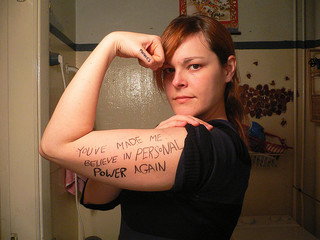What’s the number one thing you strive for in your marketing and fundraising strategy? Challenge yourself to think about this for a moment. Really think. Trust me; you’ll remember it better if you think first. Don’t skip ahead.
Got a word?
There’s one word that should come to mind. This word should become your mantra. It should underscore everything you do. Your annual appeal writing. Your special events. Your newsletters. Your blog posts. Your proposals. Your reports. Your social media.
If you take this one word to heart, you’ll be leaps and bounds ahead of the competition. Moreover, this is the one word that can set you apart. That can help you build relationships like nothing else. Ready?
PERSONALIZATION.
What would it be like if you knew all your supporters, and they knew you? It would be fan-fricking-tastic! Gosh darn it; don’t you get tired of being one of the anonymous masses? Don’t you just love it when you feel personally welcomed? When someone listens to you and you can tell they really heard you? When someone cares about you and asks how you’re doing?
People used to have more of this personal connection. Back in the day, everyone knew their neighborhood grocer, butcher, bread maker and haberdasher. Then came the post WWII flight to the suburbs and with it mass-market department stores and shopping malls. No more specialization. No more personalization. Anonymous little houses on a hillside. Nonprofits fall prey to the same blandness. To the potential donor many of them look identical. They all claim to be “making a difference” and “creating change” and “saving lives.” They all send out appeals with “Dear Claire” and “thanks to you Claire” and similar stand-ins for a personal touch. But they’re not authentic; they don’t connect.
People tired of this sameness long ago. Department stores selling everything, specializing in nothing, morphed into “Chairs R Us,” “Toys R Us,” “Office Depot,” “Just Desserts,” and “Personal Shoppers.” People craved specialists. Choices. Today we’re seeing a flight back to the cities, with all the differentiation and choices they offer.
Embrace personalization and you can wake folks up! Seriously, they won’t know what hit them.
- What if the person who takes the event reservations is the same person who sits at the check-in table? And what if they greet each guest by name; then add a personal recollection like “Oh, hello Claire. So nice to meet you in person. I was the one who took your reservation. Is you puppy feeling better?”
- What if your thank you letter has a hand-written note from the executive director, or a board member, or even a staff member? Not just a slick, generic “thanks so much for making a difference,” but something at least as personal as “so glad you can come to the event this year; I’ll look for you there.” Even better would be to add something remembered from your last encounter. Something like: “Can’t wait to see what dress you’ll be wearing this year!” And then what if the note writer actually makes a point of looking for you at the event?
- What if the newsletter you receive leads with hand-selected articles about the program for which you earmarked your donation? What if everything you receive is tailored through list segmentation, so that nothing seems generic?
- What if the same volunteer who called to thank you for your gift last year is the one who calls to ask you this year? And what if they remember something from your call last year and ask you about it? Or if they simply look at the program for which you earmarked your last gift, reference it, and tell you how it’s doing — thanks to your help?
- What if you receive a card on your birthday? And not just a plain card with a computer-generated signature, but one with a personal note from someone you know. Or one with a special gift for something you like (they noticed you always buy ice cream at their café… or attend the jazz series… or give to save endangered tigers; then enclose a coupon or sticker related to your area of interest).
- What if someone noticed you weren’t feeling well one day; then called a day or two later to check in on you? What if they asked if there was anything they could do to help?
Chances are good that any of these personal strategies would make you feel welcomed, cared for and favorably impressed.
Early in my career I received a piece of fundraising advice that has stuck with me to this day: People are all people.
Even businesses and foundations are people. Wealthy. Poor. Old. Young. Treat everyone like people. Don’t put them at arms length just because they may be different from you. Don’t be afraid of their status or size. Find a way to connect. And don’t forget that they aren’t stereotypes; no one is the same. That’s the beauty of being human. Just be human. Philanthropy means “love of humankind.”
With the digital revolution there’s been a tendency to become more robotic and sleep inducing. Don’t let tools overshadow people. Much has changed, but people are still people. People need people. People crave relationships. They’re driven to connect tribally and form communities. So moan about the digital world all you want, but don’t despair. It doesn’t mean you can no longer connect with people in real time. In fact, it means you can connect with people 24/7. Just do it with your distinct personal touch.
Personal is back in fashion. Try it on for size.
This post is part of the 2013 Philanthropy, Not Fundraising series.
Photos: Flickr – Todd Martin, Johanna MacDonald, Thomas Hawk








Claire, You always have such great advice, each time I read your blog I have a take-away. In this day when fundraisers have to keep multiple balls up in the air all at the same time, what advice would you give to help them prioritize. As hard as you try to find time for everything that needs to be done…sometimes I find the hardest thing is to find time to push back from the mad rush and spend quality time to plan. Because there is so much to do, it sometimes feels like you only inch forward slowly at each task. It can be exhausting.
I feel your pain. You are right. It can be exhausting. That’s why I wrote these posts [See 7 Practical Ways to Play at Work https://clairification.com/2012/08/07/7-practical-ways-to-play-at-work-feel-better-and-achieve-more/, Feel Better and Achieve More and Why You May Be Dull at Work: What You Can Do to Change https://clairification.com/2012/08/05/why-you-may-be-dull-at-work-what-you-can-do-to-change/ and Stop Hunkering Behind Your Desk https://clairification.com/2012/08/31/long-weekend-smit-stop-hunkering-behind-your-desk/%5D
Try to schedule in some planning time. Block it out on your calendar, and treat it as equally important to all your other “to-do’s.” Involve others in the planning time as well, because it’s just as important to make this part of your culture as it is to do it. Otherwise it becomes an isolated incident, rather than an integrated component of working effectively — both as an individual and as a team. Let your boss know you’re doing it, and consider inviting them to join. At the very least, report back as to what the planning sessions yielded. This will help show others that you’re not just taking a coffee break. 🙂
Wishing you luck!
Good advice, Claire. This is something I have tried to do since becoming the Donor Relations Manager for Orphan’s Lifeline Int’l. I have made numerous friends simply from personalizing emails to them. Now we check on each other, share concerns, pray for each other, etc. There is no substitute for a personal connection. However, the larger our organization grows, the more difficult this becomes. It’s much quicker and easier to send out form letters and emails. I don’t want to lose that personal touch, but where does one find the time when you are a one person department in a small organization?
First, congrats on what you’ve accomplished. You’re definitely on the right track! It does become more of a challenge as you grow. My best advice is to: (1) segment your mailing list according to unique characteristics different groups of donors may have in common (e.g., program for which gift is earmarked; manner in which the donor became affiliated, etc.) and try to at least customize your communications to show that you know the donor in this way; (2) pull out donors worthy of special treatment and personalize their communications (e.g., volunteers; board members; major donors, gift club donors, etc.), and (3) recruit others to help with the personalization process (e.g., program staff; volunteers). You can’t personalize every communication with a staff of one person, but you can still make your communications be thoughtful and resonant.